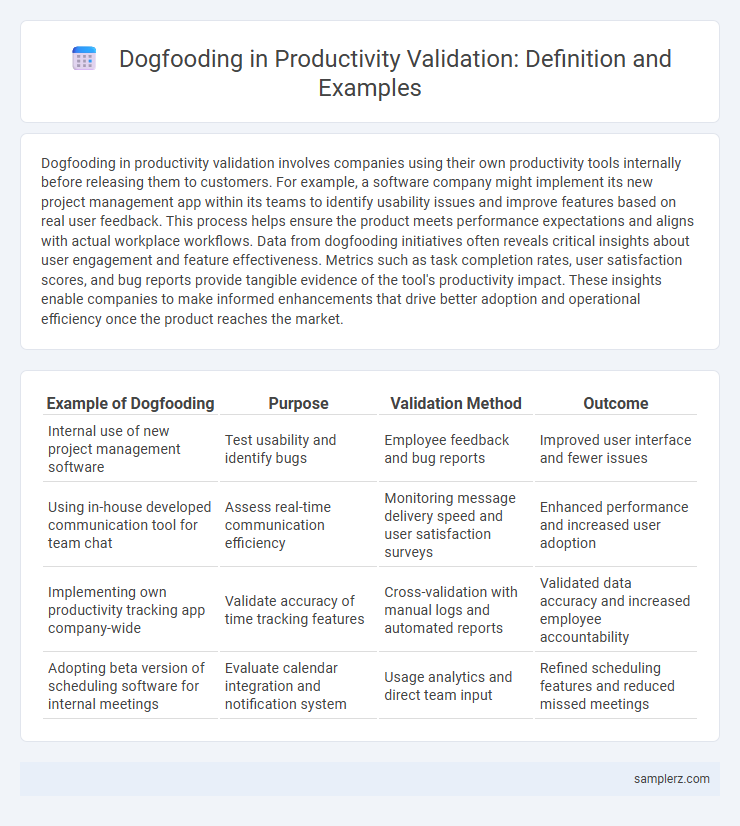Dogfooding in productivity validation involves companies using their own productivity tools internally before releasing them to customers. For example, a software company might implement its new project management app within its teams to identify usability issues and improve features based on real user feedback. This process helps ensure the product meets performance expectations and aligns with actual workplace workflows. Data from dogfooding initiatives often reveals critical insights about user engagement and feature effectiveness. Metrics such as task completion rates, user satisfaction scores, and bug reports provide tangible evidence of the tool's productivity impact. These insights enable companies to make informed enhancements that drive better adoption and operational efficiency once the product reaches the market.
Table of Comparison
| Example of Dogfooding | Purpose | Validation Method | Outcome |
|---|---|---|---|
| Internal use of new project management software | Test usability and identify bugs | Employee feedback and bug reports | Improved user interface and fewer issues |
| Using in-house developed communication tool for team chat | Assess real-time communication efficiency | Monitoring message delivery speed and user satisfaction surveys | Enhanced performance and increased user adoption |
| Implementing own productivity tracking app company-wide | Validate accuracy of time tracking features | Cross-validation with manual logs and automated reports | Validated data accuracy and increased employee accountability |
| Adopting beta version of scheduling software for internal meetings | Evaluate calendar integration and notification system | Usage analytics and direct team input | Refined scheduling features and reduced missed meetings |
Introduction to Dogfooding in Validation
Dogfooding in validation involves using your own product internally to identify issues and improve functionality before external release, ensuring higher quality and reliability. This practice accelerates feedback loops by allowing teams to experience real-world scenarios and validate features through firsthand usage. Emphasizing dogfooding enhances product confidence and streamlines the validation process in software development.
The Importance of Internal Product Testing
Dogfooding, the practice of using one's own product internally, plays a critical role in validating product functionality and user experience before public release. This internal product testing allows teams to identify bugs, usability issues, and performance bottlenecks in real-world scenarios, ensuring higher quality and reliability. Companies like Microsoft and Google leverage dogfooding to accelerate feedback loops and deliver polished, user-centric solutions.
Real-World Examples of Dogfooding for Validation
Google extensively practices dogfooding by having employees use early versions of products like Gmail and Android to identify bugs and improve user experience before public release. Microsoft employs dogfooding for Windows updates, enabling staff to test new features and performance in real-life scenarios to ensure robust validation. Facebook uses internal dogfooding to refine algorithms and interface changes, leveraging employee feedback to validate functionality under practical conditions.
How Tech Giants Practice Dogfooding
Tech giants like Microsoft and Google implement dogfooding by internally using their own software products before public release, enabling real-time feedback and rapid issue identification. This practice ensures higher product quality and accelerated innovation cycles by aligning developer experience with user expectations. Internal adoption of tools like Microsoft Teams or Google Workspace exemplifies how dogfooding drives productivity improvements through continuous validation and refinement.
Dogfooding as a Productivity Booster
Dogfooding accelerates productivity by enabling teams to rigorously test products within their own workflows, uncovering usability issues before external release. This firsthand experience drives rapid iteration and enhances feature relevance, directly boosting development efficiency. Companies like Microsoft and Google report significant time savings and quality improvements through disciplined dogfooding practices.
Benefits of Dogfooding in Product Validation
Dogfooding in product validation accelerates the identification of usability issues by allowing internal teams to experience the product firsthand, resulting in faster feedback loops and higher-quality improvements. This practice fosters a culture of ownership and accountability, as employees become invested in the product's success and authenticity. Companies like Microsoft and Google leverage dogfooding to reduce the time-to-market while enhancing feature reliability and user satisfaction.
Overcoming Challenges in Dogfooding
Overcoming challenges in dogfooding involves addressing internal resistance by fostering a culture of transparency and continuous feedback within teams. Leveraging real-time user data and iterative testing ensures early identification of product flaws, enhancing overall validation processes. Successful dogfooding accelerates product improvement cycles, reduces external testing costs, and increases end-user satisfaction.
Metrics to Measure Success in Dogfooding
Effective metrics to measure success in dogfooding include user engagement rates, error frequency, and feature adoption levels within the internal teams. Tracking time-to-resolution for bugs discovered during dogfooding helps quantify product robustness and responsiveness. High internal satisfaction scores and consistent usage patterns indicate successful validation of product usability and functionality.
Best Practices for Effective Dogfooding
Effective dogfooding practices include selecting representative users within the company to rigorously test products, ensuring early identification of bugs and usability issues. Establishing clear feedback channels and regular evaluation cycles enhances continuous improvement and aligns development with real-world usage. Prioritizing transparent communication and incentivizing participation boosts engagement and delivers valuable insights for validating product quality.
Future Trends: Dogfooding and Continuous Validation
Future trends in productivity emphasize dogfooding as a core strategy for continuous validation, enabling teams to identify and resolve issues early in the product development lifecycle. By integrating dogfooding practices with real-time feedback loops, organizations enhance product quality and accelerate release cycles. Advanced analytics and AI-driven insights further optimize validation processes, ensuring seamless user experiences and sustained innovation.

example of Dogfooding in validation Infographic
 samplerz.com
samplerz.com